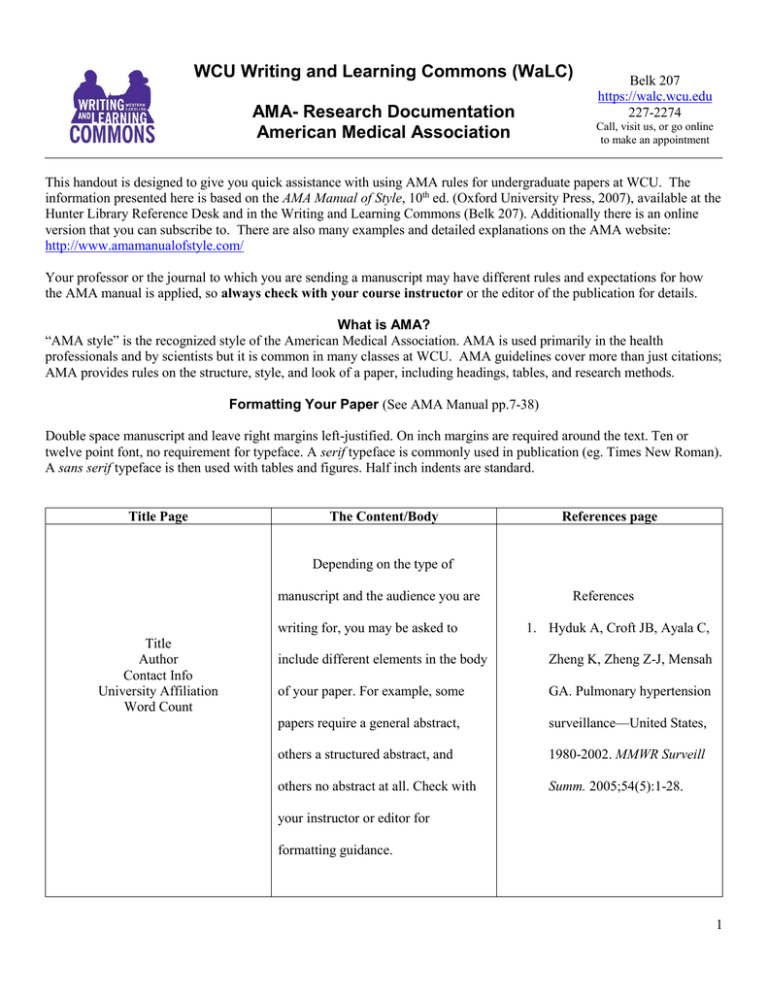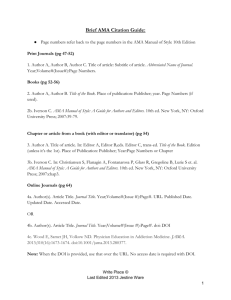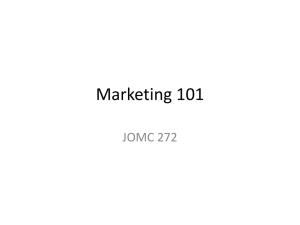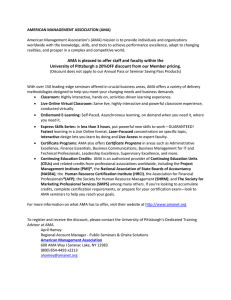WCU Writing and Learning Commons (WaLC) AMA- Research Documentation American Medical Association
advertisement

WCU Writing and Learning Commons (WaLC) AMA- Research Documentation American Medical Association Belk 207 https://walc.wcu.edu 227-2274 Call, visit us, or go online to make an appointment This handout is designed to give you quick assistance with using AMA rules for undergraduate papers at WCU. The information presented here is based on the AMA Manual of Style, 10th ed. (Oxford University Press, 2007), available at the Hunter Library Reference Desk and in the Writing and Learning Commons (Belk 207). Additionally there is an online version that you can subscribe to. There are also many examples and detailed explanations on the AMA website: http://www.amamanualofstyle.com/ Your professor or the journal to which you are sending a manuscript may have different rules and expectations for how the AMA manual is applied, so always check with your course instructor or the editor of the publication for details. What is AMA? “AMA style” is the recognized style of the American Medical Association. AMA is used primarily in the health professionals and by scientists but it is common in many classes at WCU. AMA guidelines cover more than just citations; AMA provides rules on the structure, style, and look of a paper, including headings, tables, and research methods. Formatting Your Paper (See AMA Manual pp.7-38) Double space manuscript and leave right margins left-justified. On inch margins are required around the text. Ten or twelve point font, no requirement for typeface. A serif typeface is commonly used in publication (eg. Times New Roman). A sans serif typeface is then used with tables and figures. Half inch indents are standard. Title Page The Content/Body References page Depending on the type of manuscript and the audience you are writing for, you may be asked to Title Author Contact Info University Affiliation Word Count References 1. Hyduk A, Croft JB, Ayala C, include different elements in the body Zheng K, Zheng Z-J, Mensah of your paper. For example, some GA. Pulmonary hypertension papers require a general abstract, surveillance—United States, others a structured abstract, and 1980-2002. MMWR Surveill others no abstract at all. Check with Summ. 2005;54(5):1-28. your instructor or editor for formatting guidance. 1 The Title Page On title page, include title, author, author contact info, university affiliation, and a word count for text only, exclusive of title, abstract, references, tables, and figure legends. (Title pages may differ depending on whether the author is using a structured or unstructured abstract.) The Abstract (See AMA pp. 20-23) Generally speaking, an “unstructured abstract” should include the objective, methods, results and conclusions and should not exceed 300 words. The specific journal being targeted may have its own instructions for authors, and it should be consulted for any “structured abstract.” Structured abstracts are recommended for original research reports, with recommended subheadings to include: a context statement which explains the importance of the objective, the objective, the design, the setting, patients or other participants, interventions, main outcome measure, and results. The Content/Body (See AMA p. 25) Double space manuscript and leave right margins left-justified. On inch margins are required around the text. Ten or twelve point font, no requirement for typeface. A serif typeface is commonly used in publication (eg. Times Roman). A sans serif typeface is then used with tables and figures. Half inch indents are standard. Headings (See AMA p. 26) Headings help the reader follow the sequence of ideas, and divide the text into more readable sections. Three levels usually serve. Additional levels can be added by following the second and third levels with the heading and the same format in italics. Three styles of capitalization are used with headings. Tables and Figures (See AMA pp. 81-124) AMA has very specific rules for visuals and tabulated data. For information regarding the design and the proper citation of tables, figures, or any other visual elements in your paper, refer to chapter four, page 81-124 in the AMA style guide, tenth edition. Additionally, if submitting to a journal, check with individual publishers and publications for specific styles of headings. 2 Rules for Reference List NOTE: Good research requires you to select your sources carefully and read them closely. Start by finding reliable, relevant sources. Develop an understanding of your topic, build your source list, and then start writing. Remember, the research always comes first! All sources should be included in a list at the end of your paper. When accessing an online resource, the Digital Object Identifier (DOI) number is preferred over the URL. DOI will occasionally be hidden in a URL beginning with http://dx.doi.org. If the resource has no DOI, then a URL is required. (See AMA p.63) A PMID (PubMed Identification Number) can be used to find journal articles in the search box on the PubMed web site: http://ncbi.nlm.nih.gov/PubMed The DOI may be found at the top of the article and in the search results, depending on the publication. If the DOI is available, it should be the final item in the citation. Citation of the DOI eliminates the need for the accessed date. (See AMA p. 64) Use headline capitalization for titles of journals and headings in manuscripts. Titles of articles use sentence capitalization in the list of references. Information on how to capitalize the names of organisms can be found on p.11-12 of the AMA Publication. (See AMA p. 372-377). Italicize biological nomenclature. After the first mention of the binomial species name, abbreviate the genus portion of the name (See AMA p. 743). If there are more than six authors, name the first three and then write “et al”. Example: Smith J, Renner JM, Hart K, et al (See AMA p.44) AMA in-text citations consist of consecutive superscripted Arabic numerals that correlate with the reference list. (See AMA p.42) If the author of the source is also the publisher, simply use their name twice in the citation. If the publisher is a corporation, use abbreviations as follows: Company Co, Incorporation Inc, Corporation Corp, Limited Ltd (See AMA p.56, p.458) AMA reference lists are formatted in consecutive numerical order as they are presented in the text. (See AMA p.42) In AMA, first names are initialed. Do not place a period after the initial. Example: John S (See AMA p.44) Sources: Scholarly sources are easier to cite than informal ones. If you are having trouble with a citation, look for a more reputable source. For any academic paper, use library resources. Don't just "Google" your topic. As a general rule, the minimum information acceptable for citing a printed book includes the name of the author(s), the book title and edition number (if 2nd or above), the city and state (or country) of the publisher, and the publisher’s name and year that the text was copyrighted. If the book is accessed online, the URL and date of access should be included in the citation. Printed journals should include the name of the author(s), title of the article used, the journal’s name in italics and properly abbreviated, the year, volume, and issue number, and the pages of the article (inclusive). 3 Single-word titles of journals are not abbreviated. Also, articles (i.e. a, an, the) and coordinating conjunctions (i.e. and, or, for, nor, but) do not appear in the abbreviated journal titles. For help in abbreviation of journal titles, visit the US National Library of Medicine’s catalog of journals referenced in the National Center for Biotechnology Information (NCBI)’s Database: http://www.ncbi.nlm.nih.gov/nlmcatalog/journals If the journal you are looking for is not in the database, try breaking down the title into individual words and then borrowing the abbreviations as found in other journal titles. Or consult the current Fact Sheet of title abbreviations at: http://www.nlm.nih.gov/pubs/factsheets/constructitle.html for rules on constructing your own abbreviations. Do not place article or book chapter titles inside quotation marks, unless quotation marks appear in the original form. Article titles are capitalized like sentences when found in references. Capitalize the first letter of the first word, proper names, and abbreviations that are usually capitalized. (See AMA p.372) Italicize the titles of books, journals, government bulletins, documents, and pamphlets, capitalizing the first letter of each major word. (See AMA p.925) Your list of entries should be double-spaced throughout. 4 Reference List Examples Below are the basic formats and examples of sources often used in research papers. Books (See AMA p.52-56) Print 1. Debo, A. The American H.D. Iowa City, IA: University of Iowa Press, 2012. Online 1. Herzog, H. Some We Love, Some We Hate, Some We Eat. New York, NY: Harper; 2010. http://www.amazon.com/ Accessed October 23, 2013. Chapter in a Book 1. Zwemer K. Clinical practice: Neurologic physical therapy. In: Scott R, ed. Foundations of Physical Therapy: A 21st Century Focused View. 1st ed. New York, NY. McGraw-HillAppleton & Lange; 2001: 93-102. 2. Brukner P, Khan K, Kemp J, Crossley K, Schache A, Pritchard M. Hip-related pain. In: Brukner P, Khan K, eds. Clinical Sports Medicine. 4th ed. North Ryde NSW, Australia: McGraw-Hill Australia; 2012:518. Chapter Authored by Book’s Editor 1. Riegelman RK. Chapter 11: Meta-analysis. In: Riegelman RK, ed. Studying a Study and Testing a Test: How to Read the Medical Evidence. 5th ed. Philadelphia: Lippincott Williams & Wilkins; 2005:99-115. Journal Articles (See AMA p.47-52, p.60) One Author 1. Hudson D. A comparison of ultrasound to goniometric and inclinometer measurements of torsion in the tibia and femur. Gait Posture. 2008; 28: 708-710. More Than One Author 1. Myers J, Shanks G, Watson T, Hudson DG. Single inclinometer vs. double inclinometer measures of lumbar spine range of motion: a validity study. Orthop Phys Ther Pract. 2009; 21(4),146-148. 5 2. Watson, T, McPherson, S. Getting off the mat: lumbar stabilization training in standing using ultrasound imagine. J Yoga Phys Ther. 2013. 3(4). doi: http:dx.doi.org/10.4172/2157-7595. Electronic Copy of a Journal 1. Watson, T, McPherson, S, Fleeman, S. Ultrasound measurement of transversus abdominis during loaded, functional tasks in asymptomatic individuals: rater reliability. PM&R.2011; 3(8). doi: 10.1016j.2011.03.015. 2. Watson, T, McPherson, S, Fleeman, S. Ultrasound measurement of transversus abdominis during loaded, functional tasks in asymptomatic individuals: rater reliability. PM&R.2011; 3(8). http://www.journals.elsevier.com/pmandr Accessed October 1, 2014. **Note: In #2 above, we have written the example as if no doi was available. In that case, use the web address for the journal publication or sponsoring organization of the journal. Do not use the database link provided in the URL address bar of the browser, or the permalink provided. Go directly to the publication’s web site. Indirect/Secondary Citation 1. Cauley JA, Lui LY, Ensrud KE, et al. Osteoporosis and fracture risk in women of different ethnic groups. JAMA. 2005;293(17):2102-2108. Cited by: Acheson LS. Bone density and the risk of fractures: Should treatment thresholds vary by race [editorial]? JAMA. 2005; 293(17):2151-2154. Article Accepted for Publication but Not Yet Published (See AMA p.60) 1. McPherson, S, Watson, T. Training of transversus abdominis activation in the supine position with ultrasound biofeedback translated to increased transversus abdominis activation during upright loaded functional tasks. PM&R. In press. doi:http://dx.doi.org/10.1016/j.pmrj.2013.11.014 Technical and Research Reports, Pamphlets (See AMA p.57) Government or Agency Bulletins (See AMA Manual p. 57, 69) 1. Western Carolina University. 20/20 Vision Focusing Our Future. Cullowhee, NC: Western Carolina University; October 2012. 6 2. Western Carolina University. 20/20 Vision Focusing Our Future. Cullowhee, NC: Western Carolina University; October 2012. Retrieved from http://www.wcu.edu/WebFiles/PDFs/Strategic_Plan_2020.pdf. Accessed October 23, 2013 Pamphlets 1. Protect Your Friends and Family from Tuberculosis. Atlanta, GA: Centers for Disease Control and Prevention, U.S. Department of Health and Human Resources; 2005. Legal Matters Citation of Cases (See AMA Manual p. 73) To cite a court case, use only the surnames of the first individual listed on each side, separated by a lower-case v not followed by a period. You should also provide the volume number and, if provided, series number of the reporter from which you obtained the court case, the official reporter abbreviation, the first page of the case and the specific pages used, and the year of the decision. 1. School Board v Nassau City v Arline, 480 US 273, 287 (1987). 2. Addington v Texas, 441 US 418, 426 (1979). If you are referencing a decision made by the US Court of Appeals, you should also include the abbreviation of the ruling circuit court. 1. Wilcox v United States, 387 F2d 60 (5th Cir 1967). 2. Scoles v Mercy Health Corp, 887 F Supp 765 (ED Pa 1994). Non-Print Sources Interviews Conducted by the Author of the Research Paper (See AMA Manual p. 61) Please note that personal communications (including conversations, interviews, letters, etc.) are not listed with the references. In-text references should include the type of correspondence, the name of the second party, and the month and year of correspondence. This may be done as follows: In a conversation with H. E. Marman, MD (August 2005)… According to a letter from H. E. Marman, MD, in August 2005… Similar findings have been noted by Roberts6 and by H. E. Marman, MD (written communication, August 2006)… 7 Audiotapes, Videotapes, DVDs (See AMA p.62) 1. Diener, S. (producer) & Sholder, J. (director). The Hidden [Motion picture]. USA: Heron Communications; 1987. 2. Ayers S. Terrorism: Medical Response [DVD]. Edgartown, MA: Emergency Film Group; 2002. Transcript of Television and Radio Programs (See AMA p.62) 1. 'Nothing Gold' stays long in Appalachia. [Radio broadcast]. Weekend Edition Saturday. National Public Radio. February 16, 2013. 2. Shutting out Tourette’s syndrome [transcript]. 60 Minutes. CBS television. January 17, 2005. Items Presented at a Meeting but Not Yet Published (See AMA p.60) 1. Westrick RB, Dembowski S, Glenesk K, Gerber JP, Johnson M. Risk of determination for patients receiving dry needling treatment by novice practitioners in a direct access physical therapy clinic: A retrospective review. Presented at: Combined Sections Meeting of the American Physical Therapy Association; February 4, 2014; Las Vegas, NV. 2. Barnes K, Bermudez R, Bowen J, Lysik B, Vandenraadt W, Worley S. Effectiveness of a community-based exercise program on fall risk in older adults: An intervention study. Presented at: Western Carolina University Graduate Research Symposium; March 27, 2014; Cullowhee, NC. Course Lecture Notes 1. Hyatt A. International Standards for the Neurological and Functional Classification of Spinal Cord Injury [class lecture notes]. Cullowhee, NC: Western Carolina University; September 2, 2014. Electronic Information Basic Websites (See AMA p.68) 1. John W. Bardo's Fine & Performing Arts Center Western Carolina University web site: http://www.wcu.edu. Accessed October 23, 2013. 8 Electronic Copy of a Journal Article Retrieved from a Database (See AMA p.70) 1. Author(s). Title. Journal Name. Year; vol(issue No.):inclusive pages. http://archpedi.amaassn.org/cgi/content/full/158/2/106. Published date. Updated date. Accessed June 1, 2001. 2. Kitajima TS, Kawashima SA, Watanabe Y. The conserved kinetochore protein shugoshin protects centromeric cohesion during meiosis. Nature. 2004;427(6974):501-517. doi:10.1038/nature02312. Daily Newspaper Article, Electronic Version Available by Search (See AMA p.69) 1. Jaffe S. Therapy plateau no longer ends coverage. The New York Times. February 4, 2013. http://newoldage.blogs.nytimes.com/2013/02/04/therapy-plateau-no-longer-ends-coverage/. Accessed April 20, 2014. US Government Report Available on Government Agency Website (See AMA p.69) 1. Dafney, L. Gruber J. Does public insurance improve the efficiency of medical care? Medicaid expansions and child hospitalizations. http://www.nber.org/papers/w7555. National Bureau of Economic Research working paper w7555. Published February 2000. Accessed February 26, 2004. 2. Johnson DL, O’Malley PM, Bachman JG. Secondary School Students. Bethesda, MD: National Institute on Drug Abuse; 2001. Monitoring the Future: National Survey Results on Drug Use, 1975-2000; vol 1. NIH publication 014924. http://www.monitoringthefuture.org/pubs/ monographs/vol1_2000.pdf. Published August 2001. Accessed February 27, 2004. 9 In-Text (Parenthetical) Citations (See AMA p.41-45) In-Text References and Numbering Whenever you first cite a reference within the text, use the appropriate consecutive Arabic numeral superscript. Once a citation has been assigned an Arabic numeral, it keeps the same numeral whenever it appears in text again. Place the superscript outside of periods and commas but inside semicolons and colons, for example: As noted previously,2,5-7,15 AND The derived data were as follows4,5: Place the superscript immediately after a clinical author’s surname, for example: Smith7 reported on the survey; Smith and Jones8 reported on the survey; Smith et al9 reported on the survey. Do not place the superscript after a number or unit of measure. Instead, place the superscript immediately after a corresponding word or phrase within the sentence containing the number or measurement, for example: The smallest lesion found in the second study10 was 1 cm. Examples: Kalichman and Vulfons1 suggest that the deep method of dry needling be used as the “method of choice” in addressing muscular trigger points, because they have been shown to be more effective than superficial dry needling. At least five guidelines2-7, all assessing the treatment effects on outcomes for knee osteoarthritis, have recommended the use of muscle strengthening and aerobic exercise, education, weight loss as indicated, and NSAIDs as needed. Authors reported a mean pre-procedural VISA score8 of 39.8 before patients received treatment. 10 Plagiarism (See AMA Manual p. 158) Plagiarism is representing the words or ideas of someone else's as one's own in any academic exercise. Whether intentional or unintentional, plagiarism can result in an "F" in the course and/or expulsion from the University as well as other financial sanctions. WCU's Academic Integrity Policy (http://academicintegrity.wcu.edu),the Western Carolina University Code of Student Conduct (http://www.wcu.edu/WebFiles/PDFs/WCU_Code_of_Student_Conduct.pdf), and your instructor’s syllabus outline the reporting and resolution process, and the various sanctions for plagiarism. 11



